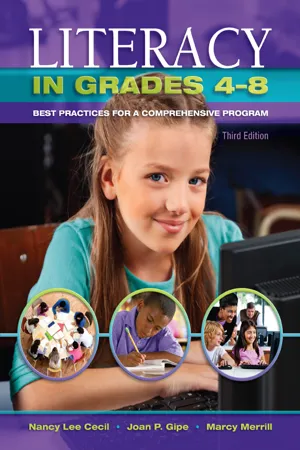
Literacy in Grades 4-8
Best Practices for a Comprehensive Program
- 420 pages
- English
- ePUB (mobile friendly)
- Available on iOS & Android
Literacy in Grades 4-8
Best Practices for a Comprehensive Program
About this book
Comprehensive yet succinct and readable, Literacy in Grades 4-8, Third Edition offers a wealth of practical ideas to help preservice and practicing teachers create a balanced and comprehensive literacy program while exploring the core topics and issues of literacy in grades 4 through 8. It addresses teaching to standards; differentiating instruction for readers and writers; motivating students; using assessment to inform instruction; integrating technology into the classroom; working with English learners and struggling readers; and connecting with caregivers. Selected classroom strategies, procedures, and activities represent the most effective practices according to research and the many outstanding classroom teachers who were observed and interviewed for the book.
The Third Edition includes added material connecting the Common Core State Standards to the instruction and assessment of literacy skills; a combined word study and vocabulary chapter to help readers integrate these important topics in their teaching; more on technology, including comprehension of multimodal texts, enhancing writing instruction with technology tools, and teaching activities with an added technology component; added discussion of teacher techniques during text discussions, strategic moves that help students become more strategic readers.
Key features: In the Classroom vignettes; more than 50 activities,some with a technology component; questions for journal writing and for projects and field-based activities; troubleshooting sections offering alternative suggestions and activities for those middle-grade students who may find a particular literacy focus challenging.
Frequently asked questions
- Essential is ideal for learners and professionals who enjoy exploring a wide range of subjects. Access the Essential Library with 800,000+ trusted titles and best-sellers across business, personal growth, and the humanities. Includes unlimited reading time and Standard Read Aloud voice.
- Complete: Perfect for advanced learners and researchers needing full, unrestricted access. Unlock 1.4M+ books across hundreds of subjects, including academic and specialized titles. The Complete Plan also includes advanced features like Premium Read Aloud and Research Assistant.
Please note we cannot support devices running on iOS 13 and Android 7 or earlier. Learn more about using the app.
Information
CHAPTER ONE
A Comprehensive Literacy Program for Grades 4–8

FOCUS QUESTIONS
in the classroom
What Is Literacy?
Literacy Instruction and the Constructivist Model
Table of contents
- Cover
- Title Page
- Copyright Page
- Table of Content
- Preface
- About the Authors
- Chapter One a Comprehensive Literacy Program for Grades 4–8
- Chapter Two Assessment of Progress in Literacy
- Chapter Three Fostering Oral Language
- Chapter Four Vocabulary Instruction
- Chapter Five Reading Comprehension
- Chapter Six Writing Instruction
- Chapter Seven Literacy in the Content Areas Learning From Informational Text
- Chapter Eight Fluency
- Chapter Nine Differentiating Instruction for Diverse Classrooms
- Chapter Ten Fostering Literacy in and Beyond the Classroom
- Chapter Eleven Connecting School and Home
- Chapter Twelve Literacy in Grades 4–8 Orchestrating a Balanced and Comprehensive Program
- Appendices
- Glossary
- Author Index
- Subject Index